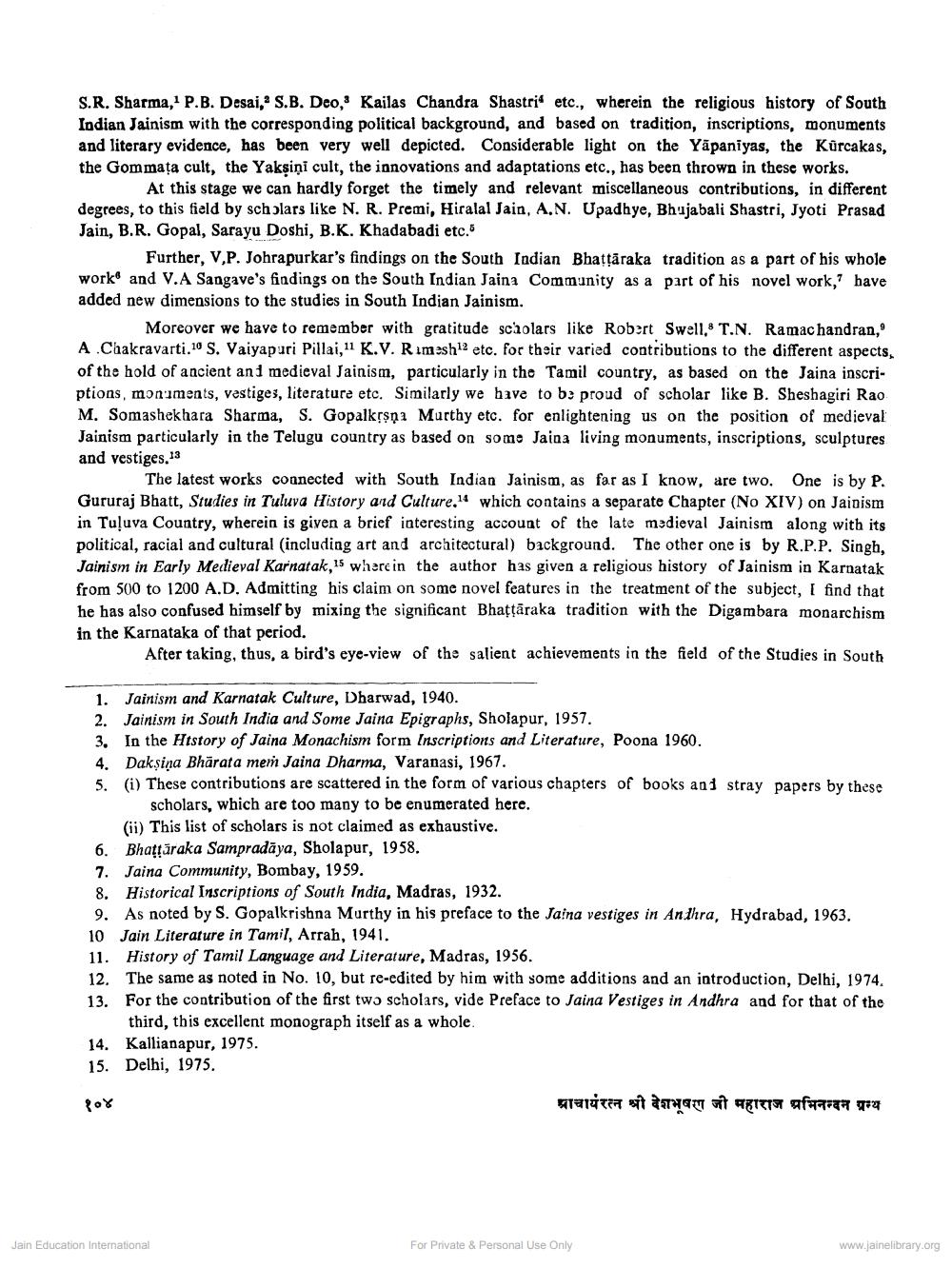________________
S.R. Sharma, P.B. Desai, S.B. Deo, Kailas Chandra Shastri" etc., wherein the religious history of South Indian Jainism with the corresponding political background, and based on tradition, inscriptions, monuments and literary evidence, has been very well depicted. Considerable light on the Yāpaniyas, the Kurcakas, the Gommața cult, the Yakşiņi cult, the innovations and adaptations etc., has been thrown in these works.
At this stage we can hardly forget the timely and relevant miscellaneous contributions, in different degrees, to this field by scholars like N. R. Premi, Hiralal Jain, A.N. Upadhye, Bhujabali Shastri, Jyoti Prasad Jain, B.R. Gopal, Sarayu Doshi, B.K. Khadabadi etc.
Further, V.P. Johrapurkar's findings on the South Indian Bhattāraka tradition as a part of his whole work and V.A Sangave's findings on the South Indian Jaina Community as a part of his novel work,' have added new dimensions to the studies in South Indian Jainism.
Moreover we have to remember with gratitude scholars like Robert Swell, T.N. Ramachandran, A.Chakravarti.10 S. Vaiyapuri Pillai, 11 K.V. Rimesh12 etc. for their varied contributions to the different aspects, of the hold of ancient and medieval Jainism, particularly in the Tamil country, as based on the Jaina inscriptions, monuments, vestiges, literature etc. Similarly we have to bo proud of scholar like B. Sheshagiri Rao M. Somashekhara Sharma, S. Gopalkęsņı Murthy etc. for enlightening us on the position of medieval Jainism particularly in the Telugu country as based on some Jaina living monuments, inscriptions, sculptures and vestiges.13
The latest works connected with South Indian Jainism, as far as I know, are two. One is by P. Gururaj Bhatt, Studies in Tuluva History and Culture.14 which contains a separate Chapter (No XIV) on Jainism in Tuluva Country, wherein is given a brief interesting account of the late medieval Jainism along with its political, racial and cultural (including art and architectural) background. The other one is by R.P.P. Singh. Jainism in Early Medieval Karnatak, 15 where in the author has given a religious history of Jainism in Karnatak from 500 to 1200 A.D. Admitting his claim on some novel features in the treatment of the subject, I find that he has also confused himself by mixing the significant Bhattāraka tradition with the Digambara monarchism in the Karnataka of that period.
After taking, thus, a bird's eye-view of the salient achievements in the field of the Studies in South
1. Jainism and Karnatak Culture, Dharwad, 1940. 2. Jainism in South India and Some Jaina Epigraphs, Sholapur, 1957. 3. In the Htstory of Jaina Monachism form Inscriptions and Literature, Poona 1960. 4. Dakşina Bhārata mes Jaina Dharma, Varanasi, 1967. 5. (i) These contributions are scattered in the form of various chapters of books and stray papers by these
scholars, which are too many to be enumerated here. (ii) This list of scholars is not claimed as exhaustive. 6. Bhattāraka Sampradāya, Sholapur, 1958. 7. Jaina Community, Bombay, 1959. 8. Historical Inscriptions of South India, Madras, 1932. 9. As noted by S. Gopalkrishna Murthy in his preface to the Jaina vestiges in Andhra, Hydrabad, 1963. 10 Jain Literature in Tamil, Arrah, 1941. 11. History of Tamil Language and Literature, Madras, 1956. 12. The same as noted in No. 10, but re-edited by him with some additions and an introduction, Delhi, 1974. 13. For the contribution of the first two scholars, vide Preface to Jaina Vestiges in Andhra and for that of the
third, this excellent monograph itself as a whole. 14. Kallianapur, 1975. 15. Delhi, 1975.
१०४
at sit asta at Agia afaa 72
Jain Education International
For Private & Personal Use Only
www.jainelibrary.org




